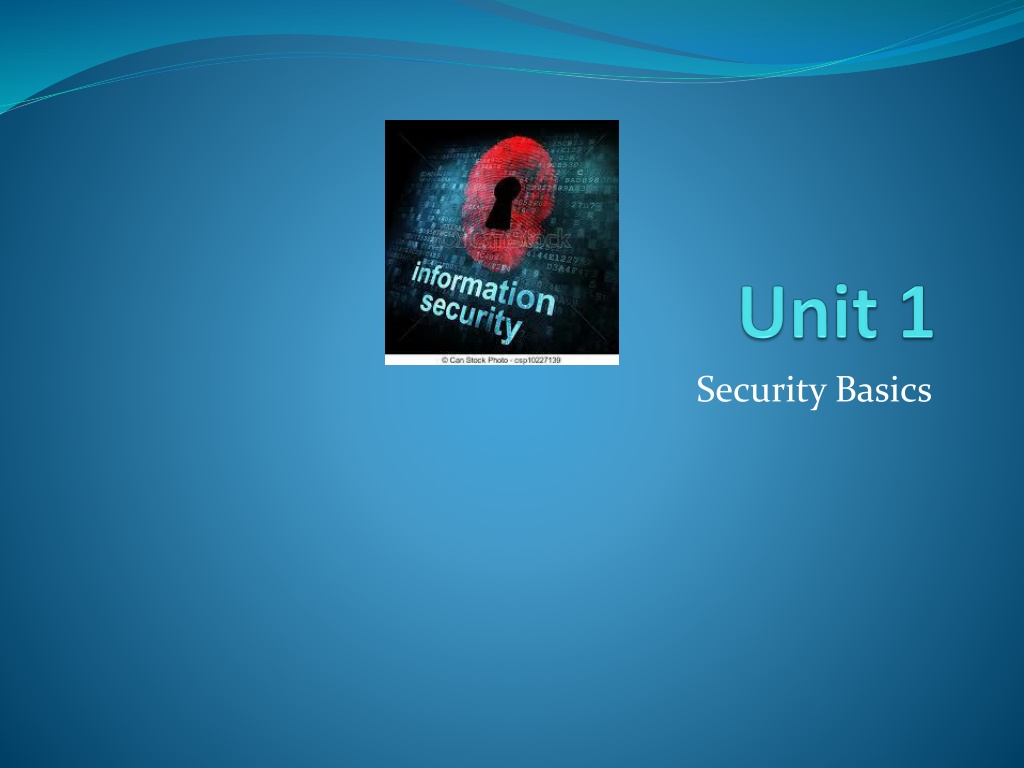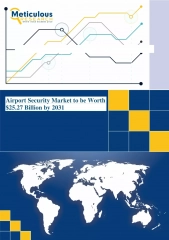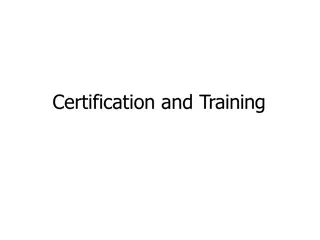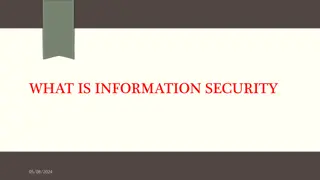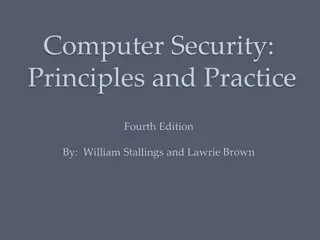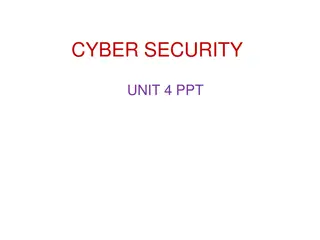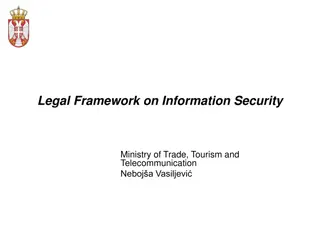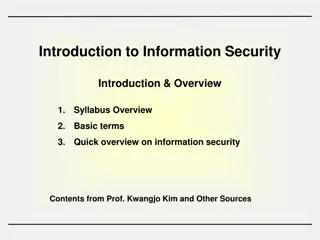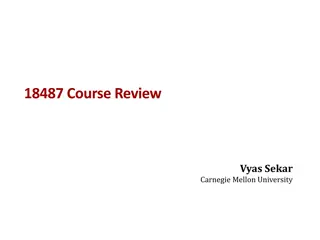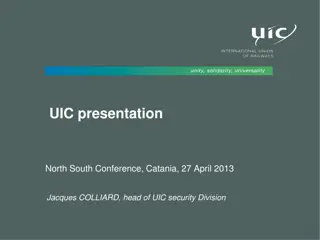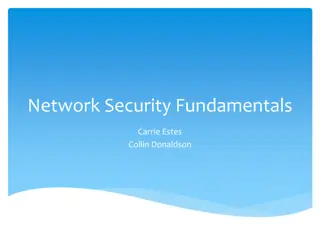Information Security Fundamentals
Recent events highlight the critical need for robust information security measures due to the increasing challenges posed by unauthorized access, lack of awareness, and the use of technology. This comprehensive guide covers key principles and techniques for enhancing data security, emphasizing the importance of management involvement in addition to technological solutions.
Download Presentation

Please find below an Image/Link to download the presentation.
The content on the website is provided AS IS for your information and personal use only. It may not be sold, licensed, or shared on other websites without obtaining consent from the author.If you encounter any issues during the download, it is possible that the publisher has removed the file from their server.
You are allowed to download the files provided on this website for personal or commercial use, subject to the condition that they are used lawfully. All files are the property of their respective owners.
The content on the website is provided AS IS for your information and personal use only. It may not be sold, licensed, or shared on other websites without obtaining consent from the author.
E N D
Presentation Transcript
CONTENT 1. INTRODUCTION 2. SECURITY 3. ELEMENTS OF INFORMATION SECURITY 4. SECURITY POLICY 5. SECURITY TECHNIQUES 6. STEPS FOR BETTER SECURITY 7. CATEGORY OF COMPUTER SECURITY 8. THE OPERATIONAL MODEL OF N/W SECURITY 9. SECURITY SERVICES 10. BASIC N/W SECURITY TERMINOLOGY 11. SECURITY ATTACKS
How safe is your information? Recent events show that commercial, personal and sensitive information is very hard to keep secure, and some estimates point to 2007 as being the worst year on record for data loss. As breaches in information security continue to make headline news, it is becoming increasingly clear that technological solutions are not the only answer. Research conducted in 2007 suggests that at least 80% of data leakages are caused by staff rather than IT systems (source: Financial Times/Forrester Research, Nov-07). It is clear therefore that Information Security should be viewed as a management function rather than one of IT alone. Here, the syllabus outline the main management principles designed to help you secure your data, and raise awareness of the issues involved.
1.1 SECURITY Challenges in Security? 1.Use of computer with internet 2. Software tools are available freely 3. Importance of information 4.Lack of awareness/ignorance/hesitation PROTECTION 1.Unahorized Access by intentionally or unintentionally.
To protect the operation of any organization 1.Physical Security:- Access control to physical device E.g:- Pen drive, Hard drive, CD/DVD, Computer, 2. Private Security :- Individual or group 3. Project Security :- Design , Code operation security
Introduction Information:- Computers, Networks, Internet, Mobile. Security:-trying to understand how to protect. The various dangers & pitfalls when we use technology. The consequences of not setting up the right Security Policies Security Framework Security Technology
Why is Security Required? Business & different types of transactions r being conducted to a large extent over Internet. Inadequate or improper security mechanism can bring whole business down or play havoc with people s lives! Since Electronic Documents & Messages r now becoming equivalent to proper documents in terms of their legal validity & binding.
Why Study Information Security Businesses collect mass amounts of data about their customers, employees, and competitors. Most of this data is stored on computers and transmitted across networks. If this information should fall into the hands of a competitor, the result could be loss of business, lawsuits and bankruptcy. Protecting corporate data is no longer an option, it is a requirement.
Information Security Protecting information and information systems from unauthorized access, disruption, modification, or destruction. use, disclosure, Background Throughout history, confidentiality of information has always played a key role in military conflict. In Past No or little security.
The Need for Security(Current Scenario) Now a days Importance of data was truly realized. Financial & Personal data Therefore various areas in security began to gain prominence. Typical Examples of Basic Security Mechanism: Authenticate a User->id, pw Encode->DB->Not Visible to user who do not have the right permission. Organization employed their own mechanism.
The Need for Security In Modern Life Internet took the world by storm. Technology Improved Communication Infrastructure became extremely mature. Newer & newer applications begins to developed for various user demands & need. Soon peoples realized that basic security measures were not quite enough.
Information traveling from a client to a server over the internet.
Some real time attacks Russian Attacker Maxim actually manage to intruder into a merchant Internet site & obtained 300,000 credit card numbers from its DB. He then attempted extortion by demanding protection money($100,000) from the merchant. The merchant refused to oblige. Following this, the attacker published about 25,000 of the credit card numbers on the internet! Some banks reissued all the credit cards at a cost of $20 per card & others forewarned their customers about unusual entries in their statements.
Consequences of Attack Great Losses-both in terms of finance & goodwill. Cost of attack $20*300000=$6M Another Example:- 1999 Swedish hacker broke into Microsoft s Hotmail Website & created a mirror site. This allowed anyone to enter any Hotmail user s email id & read their emails. 2005 survey about the losses that occur due to successful attacks on security. $455,848,000 Next year this figure reduced to $201,757340!
Modern Nature Of Attack 1. Automating Attacks:- Traditional Attack: Produce Coins using machinery & Bring them into circulation. Modern Attack: Steal half a dollar from million accounts in a few minutes time digitally. 2. Privacy Concern:-Every Company are collecting & processing lots of information about us. Without we realizing when & how it is going to be used. 3. Distance does not matter:- Attack Can be launched from the distance. E.g:- In 1995, a Russian hacker broke into Citibank s computer remotely, stealing $12M. Although the attacker was traced, it was very difficult to get extradited him for the court case.
1.2 ELEMENTS OF INFORMATION SECURITY This will Help us understand the attacks better & also help us in thinking about the possible solution to tackle it. Information Security provide services to user.
Principle/Goals Of Security These r the 4 chief principles of security. Confidentiality:- Is msg seen by someone else? 2. Authentication:- Do u trust the sender of msg? 3. Integrity:- Is the meg changed during transmit? 4. Non-repudiation:- Can sender refute the msg? Above principles r related to a particular message. There r 2 more linked to overall system as a whole. 5. Access Control:- Who can Access what? [ACL] 6. Availability:- Information should be available timely. 1.
Confidentiality Confidentiality is the process of preventing disclosure of information individuals or systems. to unauthorized Examples: Credit card Confidentiality is necessary, but not sufficient to maintain privacy
Interception Causes Loss of Message Confidentiality
Authenticity In computing, e-Business and information security it is necessary to ensure that the data , transactions, communications or documents (electronic or physical) are genuine (i.e. they have not been forged or fabricated.) Examples: Passport, Credit card Accounts, academic transcripts
Fabrication is possible in absence of proper authentication
Integrity Integrity means that data cannot be modified/change without Authorization Examples: Manual deletion or alteration or creation of important data files, Virus infection, Employee altering their own salary , website vandalism, polling fraud.
Modification Causes Loss of Message integrity
Non-Repudiation It is a complex term used to describe the lack of deniability of ownership of a message, piece of data, or Transaction. Examples: Proof of an ATM transaction, a stock trade, or an email
It does not allow the sender of a message to refute the claim of not sending that message
Access Control Role Management->User Side->Which user can do what. Rule Management->Resource Side->Which resources r accessible and under what circumstances. Access Control List is subset of Access Control Matrix.
Availability For any information/system to serve its purpose, The information must be accessible & usable when it is needed. Computing systems used to store and process the information, the security controls used to protect it, and the communication channels used to access it must be functioning correctly. Examples: Power outages, Hardware failures, System upgrades and Preventing denial-of-service attacks
Interruption puts the availability of resources in danger.
1.3 SECURITY POLICY Risk ->Secure->Action To control the threats Providing techniques & measures(e.g Audit) Developing a secure computing platform to restrict the users to perform the only particular actions that is permitted. At the same time restrict this user too misuse their rights to use the system. 1. External Approach:- for external attacker 2. Internal Approach:- for inside environmental attack
1.4 SECURITY TECHNIQUES Cryptographic Techniques:- Confidentiality & integrity of data Authentication Techniques:- to guarantee that communication end-points. E.g:- who they say the are. Chain of trust techniques- authentic software Access Control- privilege & authorization Capability to detect un-patched known flaws Back up of data Anti-virus software Firewall IDS/IPS- related to access & misuse Information Security Awareness- social engineering
1.5 Steps for better Security Security is the most important aspect of computer world Following r the steps one should follow:- Assets:- Decide, Identify, Protect Risks:- identify threats, attacks, vulnerabilities, exploits, theft Protection:- find out the solutions Tools & Technique:- select Priorities:- decide the order of point 4
1.6 CATEGORY OF COMPUTER SECURITY 1. Cryptography:- Mathematical scrambling of data. 2. Data Security:- Protective measures, keep safe from un- authorized access, privacy, prevent breaches , etc. 3. Computer Security Model:- It Depends on computer architecture, specification, security issues, protection mechanism. Act as a framework for information system security policy.
Continue Network Security:- Protection during transmission, Policies & provision by Admin, Authorization & Access Control, 5. Computer Security Procedure:- strategies, guideline, policies, standards, specification, regulations & laws. 6. Security Exploits:- Vulnerabilities, Unintended & un-patched flaws in s/w, Virus, worms & Trojan horses, malwares Different types of attacks, 4.
Continue 7. Authentication:- person, computer, program 8. Identity management:- user, device, services 9. Internet policy:- whatsapp, FB, ect.. 10. Security Software
1.8 Basic N/W Security Terminology NOTE:- Covered through out the syllabus
Security Services Digital Signature Password Encryption Hash algorithms
Types of Attack Attacks: A Technical View Theoretical Concepts behind this attack. Inception:- Copying of data & program & listening to N/W Traffic. Fabrication:-Attacker may add fake records to a database. Creation of illegal objects on the computer system. Modification:-Attacker modifies Value of DB Interruption:- Resources became unavailable, lost or unusable. Causing problems to a H/W device, erasing program, Data or OS components. 1.
Passive Attack Attacker eavesdropping or monitoring of data transmission. Tries too learn something out of it & make use of it. Aims to obtain information that is in transmit. No Modification Detection harder. 1. For plain text Message Solution prevention :- encryption 2. For Encoded Message Similarity -> Pattern -> Clue
Active Attack Modification Creation of False Msg No prevention Solution Detection & Recovery
Classification of Active Attack Masquerade :- Trying to pose as another entity
References: Dr. V.K. Pachghare, Cryptography and Information Security, PHI,ISBN 978-81-303-5082-3 Atul Kahate, Cryptography and Network Security, Tata McGraw Hill,ISBN 978-0-07-064823-4 Further Reading use ppt s after this slide
Program That Attacks Virus Worms Trojan Horse Applets & ActiveX Controls Cookies Java Script VB Script Jscript Etc. Program That Attacks to cause some damage or to create confusion.
1.virus Practical Side Of Attack A piece of program code that attaches itself to another legitimate program & causes damage to the computer system or to the N/W.
1.virus Properties Of Virus Self-propagates Action /Event Driven Solution->Good backup, recovery Procedure. During its life time Virus goes through four phases:- Dormant 2. Propagation 3. Triggering 4. Execution 1.
